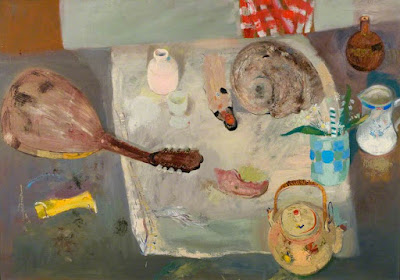 |
| George Tooker Cabinet 1951 tempera on board Wadsworth Atheneum, Hartford, Connecticut |
 |
| Michael Wishart Still Life - Chinoiserie Caché 1966 oil on canvas Atkinson Art Gallery, Southport, Merseyside |
 |
| Theo van Doesburg Composition II - Still Life 1916 oil on canvas Museo Thyssen-Bornemisza, Madrid |
 |
| Renato Guttoso Still Life in the Studio 1962 ink and watercolour on paper Tate Gallery |
 |
| Saul Steinberg Untitled (Table Still Life with Envelopes) 1975 printed paper collage, rubber stamps, crayon, colored pencils Art Institute of Chicago |
 |
| Clive Branson Still Life 1940 oil on canvas Tate Gallery |
 |
| Grant Clifford Still Life with Mandolin and Seashell 1966 oil on canvas Duncan of Jordanstone College of Art and Design, University of Dundee |
 |
| William George Gillies Still Life with Blue Gloves 1968 watercolour on paper Tate Gallery |
 |
| John Lewis Still Life No. 1 2002 acrylic on canvas Coventry University, Warwickshire |
 |
| Jane Gifford Dream Inventory, January 1997 1997 oil on canvas Government Art Collection, London |
 |
| Anonymous Dutch Artist Vanitas trompe l’oeil Letter-Rack with Death Notices ca. 1660 oil on canvas National Trust, Dyrham Park, Gloucestershire |
 |
| Evert Collier Trompe l'oeil of Newspapers, Letters and Writing Implements on a Wooden Board ca. 1699 oil on canvas Tate Gallery |
 |
| William Michael Harnett The Artist's Letter-Rack 1879 oil on canvas Metropolitan Museum of Art, New York |
 |
| John Haberle A Bachelor's Drawer ca. 1890-94 oil on canvas Metropolitan Museum of Art, New York |
 |
| Keith Vaughan Figure and Still Life 1948 charcoal and gouache on paper private collection |
La côtelette – The rib chop
Here is what I did with my body one day.
At Leysin, in 1945, in order to perform an extrapleural pneumothorax operation, a piece of one of my ribs was removed, and subsequently given back to me, quite formally, wrapped up in a piece of medical gauze (the physicians, who were Swiss, as it happened, thereby professed that my body belongs to me, in whatever dismembered state they restored it to me: I am the owner of my bones, in life as in death). For a long time I kept this fragment of myself in a drawer, a kind of body penis analogous to the end of a rib chop, not knowing quite what to do with it, not daring to get rid of it lest I do some harm to my person, though it was utterly useless to me shut up in a desk among such "precious" objects as old keys, a schoolboy report card, my grandmother B.'s mother-of-pearl dance program and pink taffeta card case. And then, one day, realizing that the function of any drawer is to ease, to acclimate the death of objects by causing them to pass through a sort of pious site, a dusty chapel where, in the guise of keeping them alive, we allow them a decent interval of dim agony, but not going so far as to dare cast this bit of myself into the common refuse bin of my building, I flung the rib chop and its gauze from my balcony, as if I were romantically scattering my own ashes, into the rue Servandoni, where some dog would come and sniff them out.
– Roland Barthes by Roland Barthes, translated by Richard Howard (Hill & Wang, 1977)